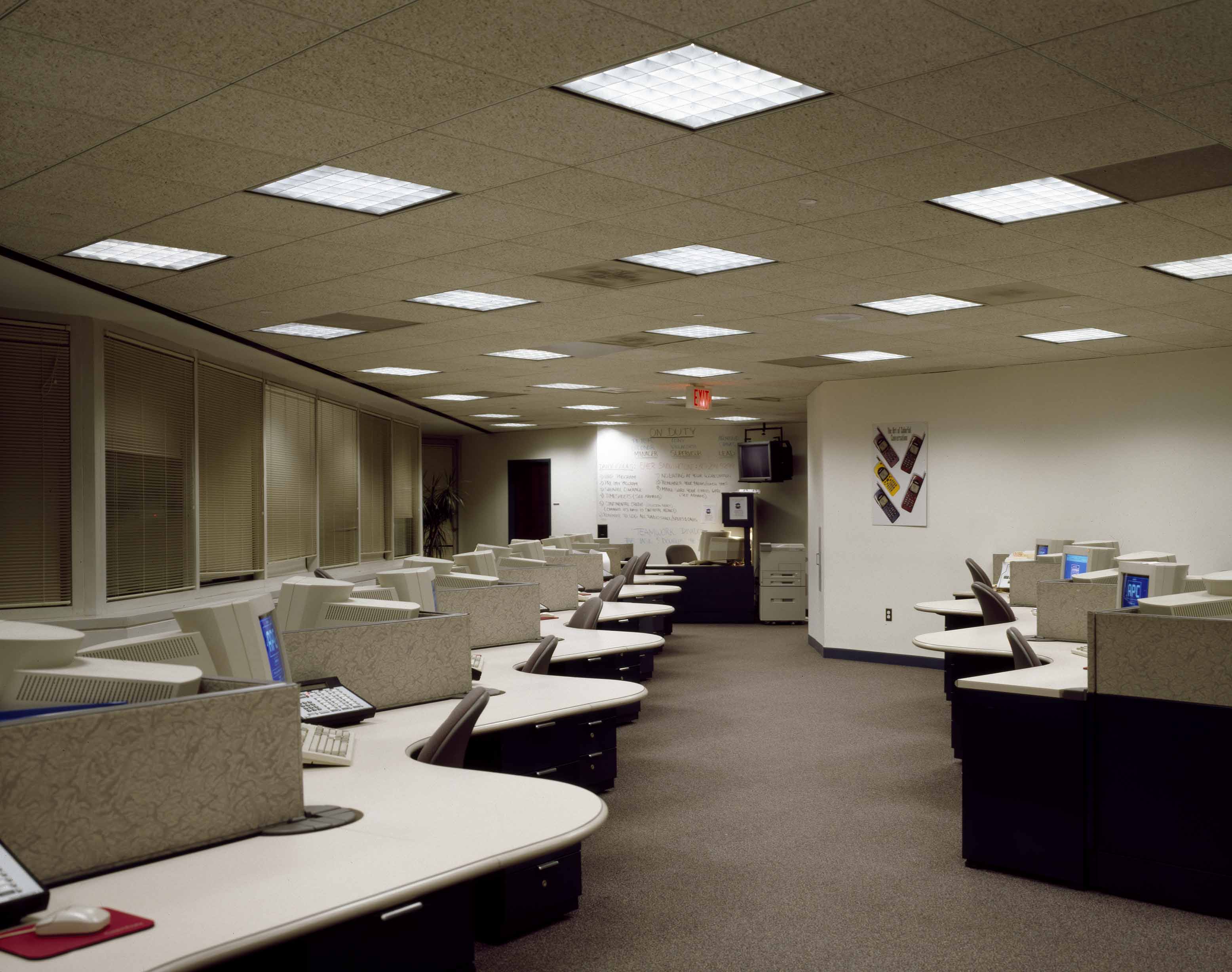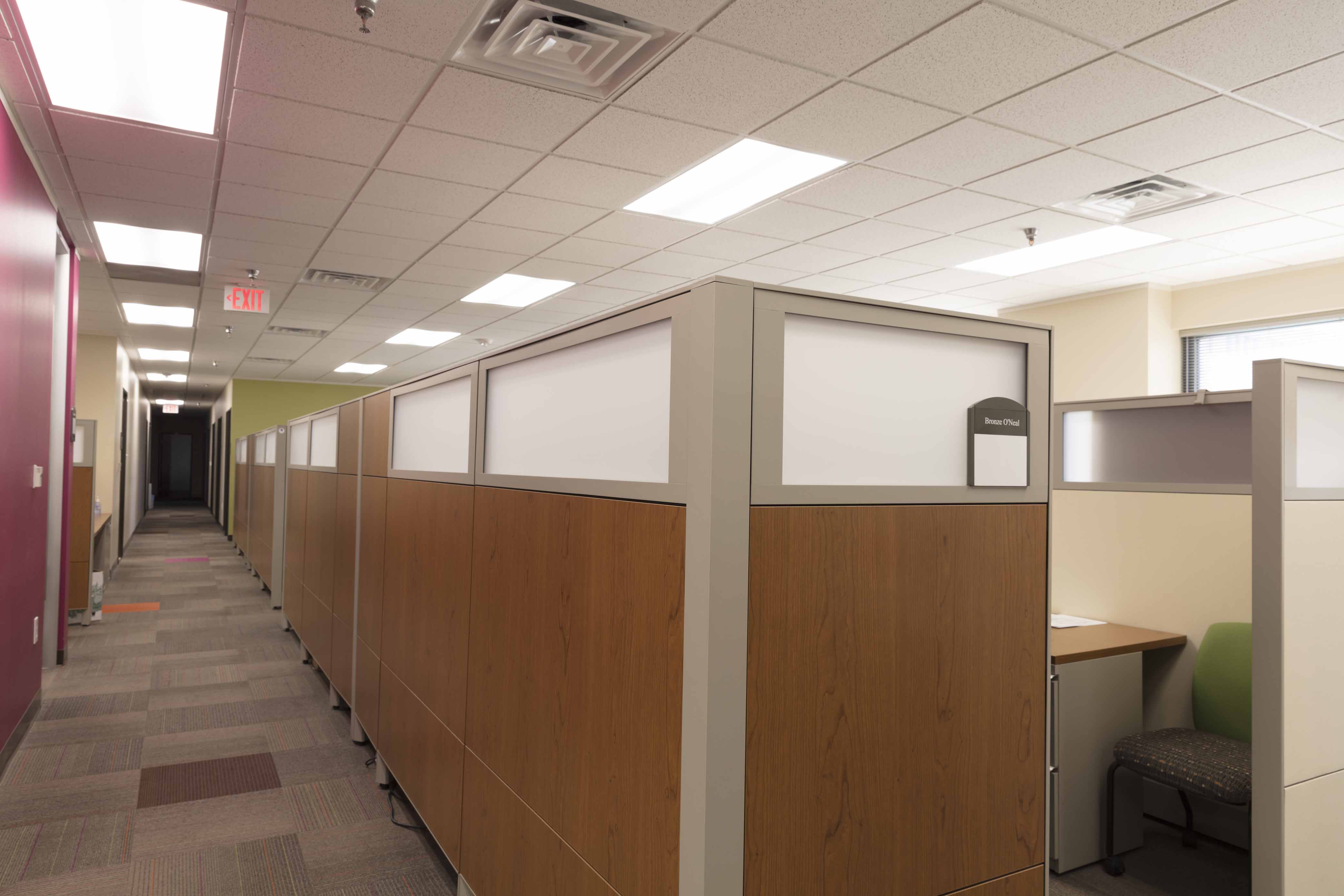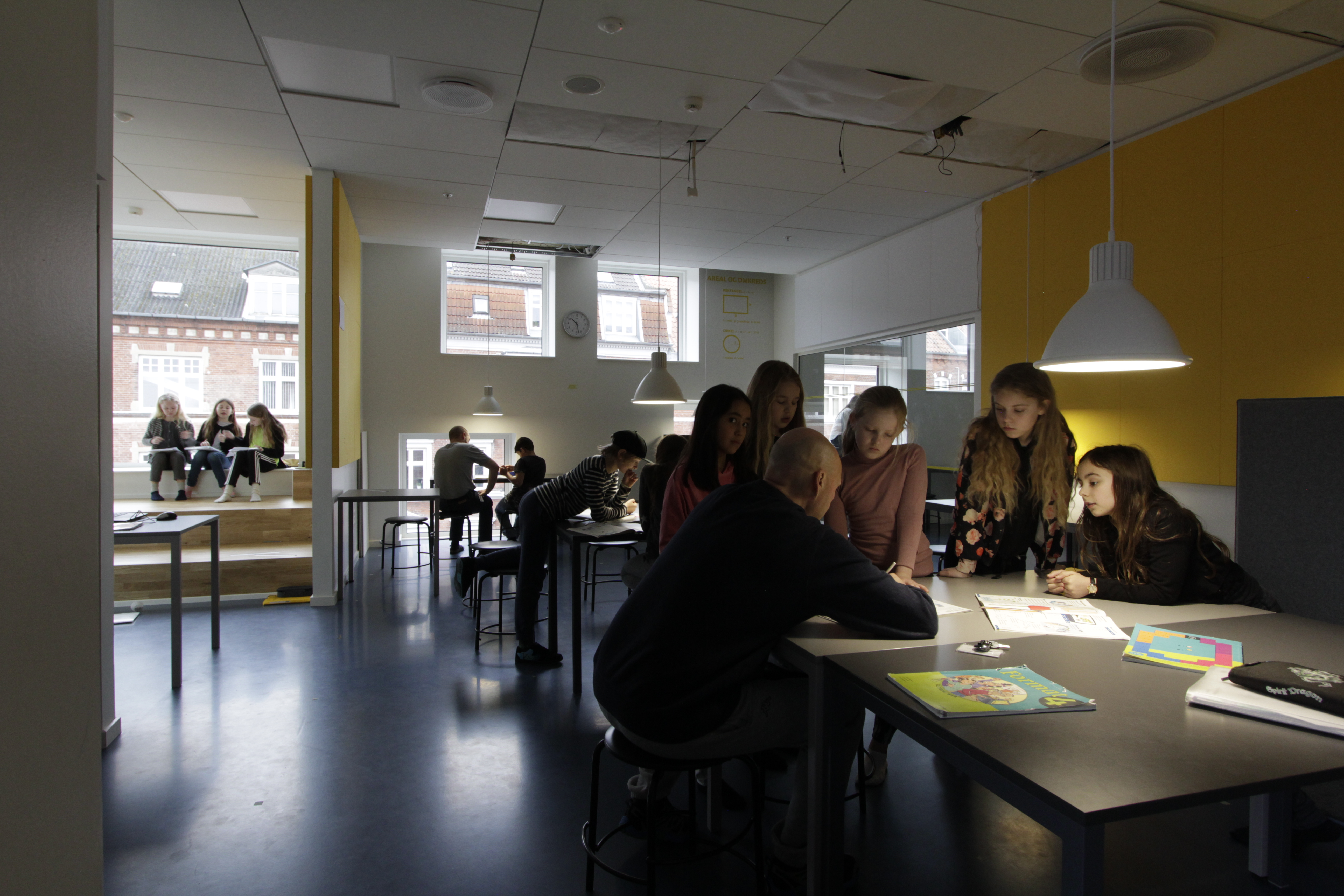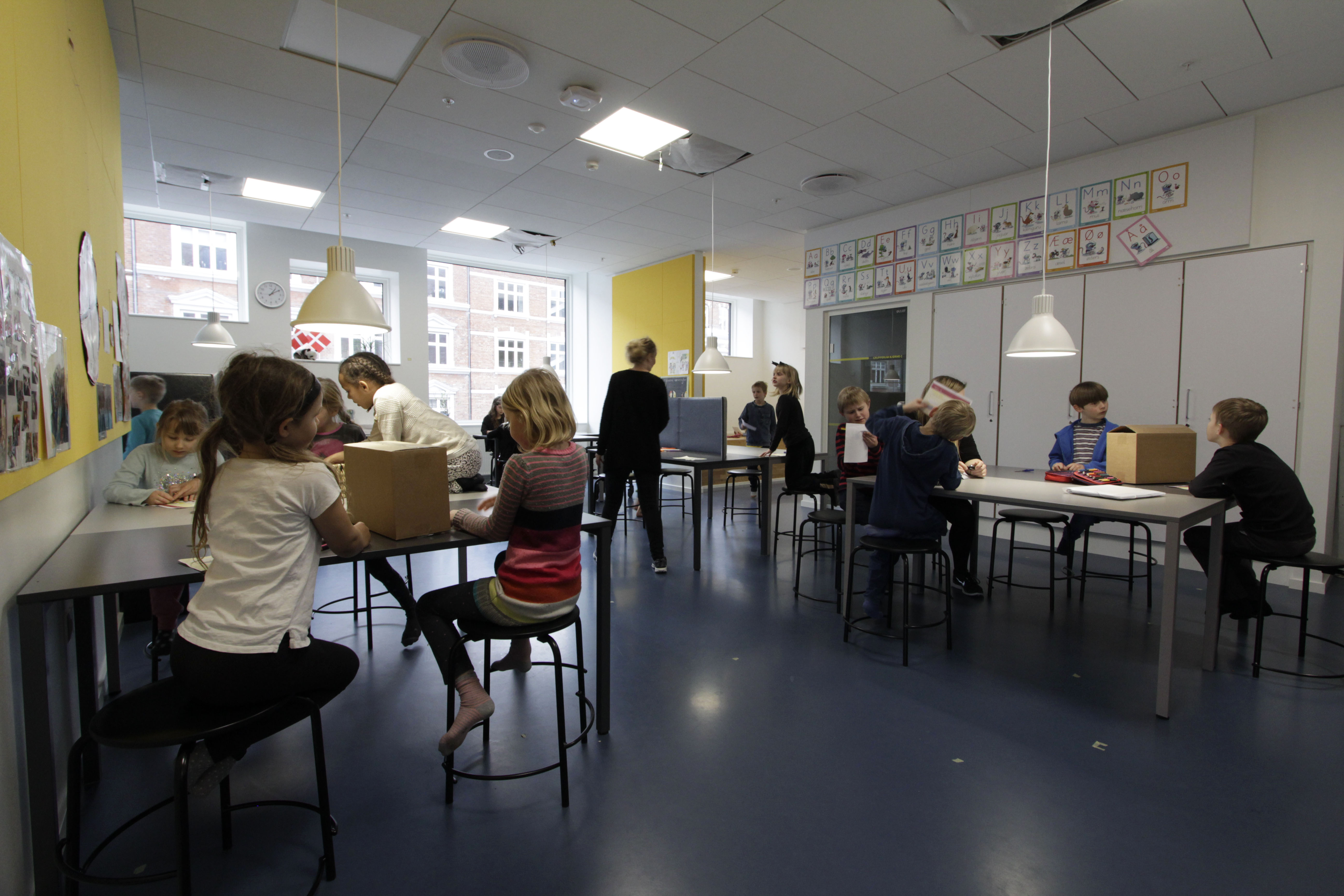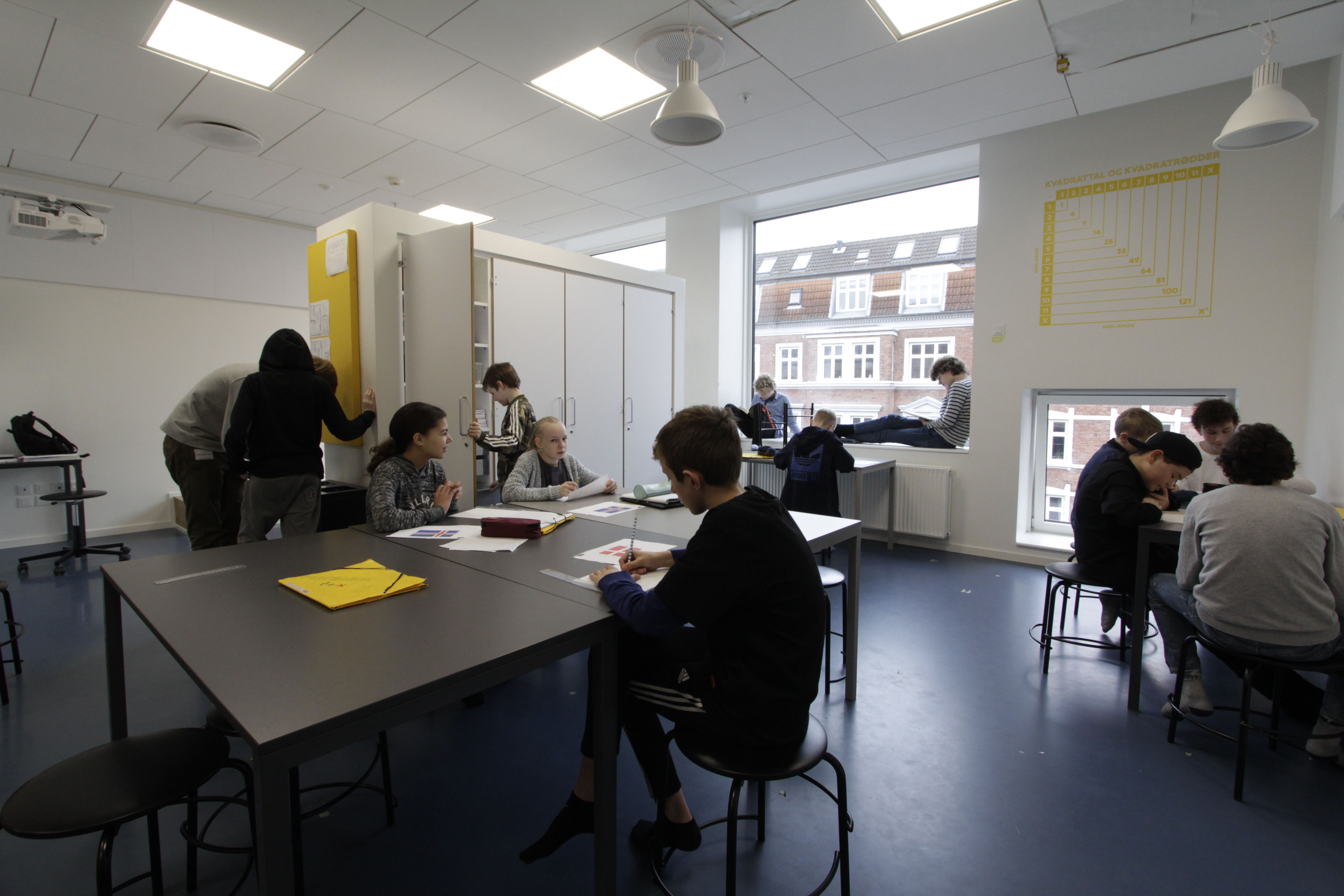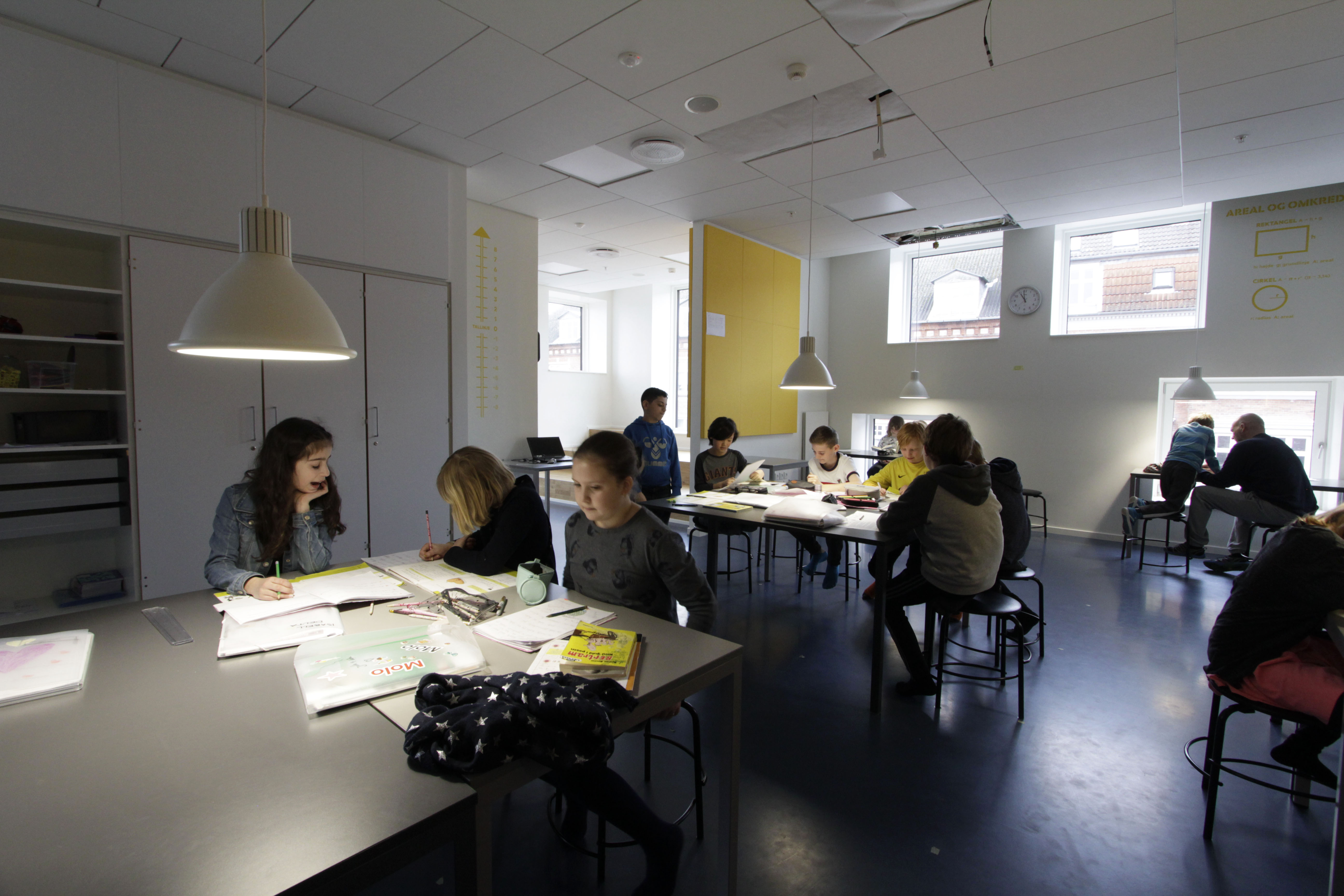
Islands of light - pendant lighting versus office distractions
A study into the use of pendant lighting at a school in Denmark could have lessons for increasing productivity and reducing stress in the workplace.
Pendant lighting could solve a perennial problem in the workplace that affects productivity and wellbeing. In addition to constant jarring by emails and phone calls, knowledge workers in typical office set-ups endure a barrage of visual and aural distractions throughout the day. The total time lost as a result can amount to more than a quarter of their working day, creating a huge hidden cost to employers and causing workplace stress. Recent research, though, at a school in Denmark suggests that creating islands of light could help mitigate these effects and might enable adults to get more done. Surprisingly, this includes reducing office noise.
To be fully productive people have to experience what psychologist Mihaly Csikszentmihalyi called flow: ‘a state in which people are so involved in an activity that nothing else seems to matter.’ But this is almost impossible to achieve in most workplaces, where, as design process expert William Belk put it ‘everyone is distracted by everything.’
 "We can assume that everyone at every company has the potential to start each day behind a large attention deficit." William Belk
"We can assume that everyone at every company has the potential to start each day behind a large attention deficit." William Belk
Belk conducted an anonymous survey of 700 self-styled 'high-performance employees’ in jobs such as architecture and financial services and found that nearly 60 percent regarded their workplace as distracting.
In an oft-quoted paper called The Cost of Not Paying Attention published in 2005, Basex IT analysts Jonathan Spira and Joshua Feintuch reckoned that ‘interruptions consume a little over two hours day, or 28 percent of the workday,’ of the knowledge workers they surveyed. This was because even a minor distraction could break a chain of thought and on average it took just over 25 minutes to resume each task. They estimated the annual cost to the US economy of these distractions at close to a trillion dollars.
An article in Applied Ergonomics in 2102 noted that ‘information work is usually performed in offices and influenced by the combined effects of acoustics, room climate, lighting and air quality,’ and that ‘an interaction effect of background speech and lighting conditions was found with regard to perceived performance during task processing.’ The main ill effects were to ‘short-term memory, reasoning ability and well-being.’
 "We spend untold thousands of dollars on free coffee and meals, gym memberships, creative perks of all kinds, yet our modern office spaces end up so similar, with so little functional creativity." William Belk
"We spend untold thousands of dollars on free coffee and meals, gym memberships, creative perks of all kinds, yet our modern office spaces end up so similar, with so little functional creativity." William Belk
In another classic study Cornell University psychologists Gary Evans and Dana Johnson also found that clerical workers in a noisy open-plan office for just three hours experience raised adrenaline levels, a clear sign of stress. In some cases, this can accumulate, leading eventually to what psychiatrist and author Edward Hallowell has named attention deficit trait. ‘Marked by distractibility, inner frenzy and impatience, ADT prevents managers from clarifying priorities, making smart decisions and managing their time,’ he wrote. ‘This insidious condition turns otherwise talented performers into harried underachievers.’
In the USA, particularly, workplaces have been dominated by the cubicle, despite it being described by the architect Frank Duffy as ‘a disease, a pathology in the office,’ which provides neither privacy nor control, and all under a grim grid of uniform ceiling lighting.
Alexi Marmot, the head of The Bartlett School of Graduate Studies at University College London says known problems with open plan offices such as ‘noise, alienation, inability to adjust light and temperature, feeling like a small cog in a large machine – need to be overcome,’ but suggests that ‘this can be achieved through attention to design.’
One solution is to create what she calls ‘places for retreat for confidential discussions and concentrated work.’ And research by the office furniture manufacturer Haworth, among others, identifies the need for clearly defined spaces both for collaboration and focus work, as part of making the workplace legible.
Clueles to how this can be achieved simply and effectively with lighting emerged from a study at a school in Denmark, in 2016. Henning Larsen architect and lighting designer Imke Wies van Mil found that a relatively simple intervention could affect students’ behaviour, enabling even easily distracted pupils to carry out tasks such as individual reading, and altering the social dynamics of the classroom.
Research into the links between lighting and learning has mainly focussed on students’ alertness in relation to general light levels or colour temperature. But van Mil wondered whether creating varied light zones would be better for some classroom activities than conventional, ‘industrial style’ homogenous illumination. Her hypothesis was that creating dark and light areas at certain times of day would focus pupils’ attention on individual tasks such as reading.
 "Putting in pendants is a very pragmatic approach to creating lighting diversity in spaces where people of any age spend their whole day." Imke Wies van Mil
"Putting in pendants is a very pragmatic approach to creating lighting diversity in spaces where people of any age spend their whole day." Imke Wies van Mil
When she installed pendant lights in four classrooms at Frederiksbjerg School in Aarhus and recorded their effect over eight months, the results confirmed that creating islands of light had a significant impact on children’s ability to focus and concentrate.
Surprisingly, the new lighting had a noticeable effect on noise levels in the classroom. In three quarters of learning situations, they dropped by up to six decibels. ‘A difference of just three decibels is perceptible; six or seven was regarded by the acoustic engineers who assisted us as significant,’ she says. ‘And this particularly benefits the children who struggle to concentrate the most.’
‘Children today learn in an environment that is more playful but they still need to be able to learn and concentrate or do their exercises and read books,’ she says. ‘The data confirms one of our hopes: that non-uniform lighting would intuitively help children sit for longer at a place or, if they were interacting with other children, it would be with those closest and not at other tables,’ she adds. ‘Teachers say this helps with tiredness and concentration but they see the biggest impact on those pupils who have the hardest time concentrating and are easily distracted.’
TEXT FRANCIS PEARCE
Related News

Smart reuse of 600 luminaires in Smedjan parking garage
When upgrading the lighting in Smedjan parking garage in Jönköping, Sweden, the property owner chose to invest in reuse instead of buying new – and the solution was Fagerhult ReLight. By reusing 618 customised luminaire frames, the climate impact could be reduced by as much as 6.3 tonnes of CO₂e compared to newly purchased materials. Smedjan parking garage is unique in its design, with spiral lanes without traditional floors, and recessed lighting luminaires in the ceiling. The luminaires were installed when the parking garage was built in the early 2000s, and when the old fluorescent tubes were replaced with LEDs, a problem occurred: the luminaire frames were custom-made and adapted to the cast concrete. “We needed to find a solution that worked with the existing frames and dimensions of the concrete structure, and ReLight made it possible,” says Martin Hulthe Landberg, Technical Administrator at Jönköping Municipality. Image gallery - Smedjan Easy reuse with ReLight The project began with a couple of luminaires being sent to Fagerhult, who used them to create a prototype. After a few rounds of development and idea exchange, the new LED kits were ready for installation. The installers could easily clear the chassis and fit the upgraded light source in place – reusing the existing luminaire frames without having to dismantle them from the concrete structure. “During the work, we closed the parking garage in stages and the installation went smoothly. We changed three to four luminaires per hour.” Each ReLight project is based on a clear core idea. The characteristics, energy efficiency, and light comfort of the luminaire must meet the same high standards of quality, safety, and durability as a new luminaire. Lower consumption and better light Even before the luminaires were updated, a lighting control system was in place. It could also be reused and integrated into the new solution. After switching to LEDs, energy consumption has been reduced by around 30% in the first six months after commissioning. “Lighting accounts for a large proportion of energy consumption, so changing to LED had a very positive effect. We also believe that we will see further reductions when we measure over the full year and when we fine-tune the system. At the same time, we have a much better light environment in the parking garage and that is a win in itself.” Quote block - Martin More projects to come In total, 618 luminaires were reused, which meant that 2,609 kg of sheet steel could be reused. This corresponds to a climate saving of 6,288 kg CO₂e – compared to if the same amount of material had been produced from virgin raw material. The ReLight solution has now been ordered for another parking garage, and the property owner see great opportunities to reduce the climate impact of their buildings through reuse. “There is often nothing wrong with the chassis or the cables. We can keep the same design and standard, save money and find a more sustainable solution. It feels very good,” says Martin Hulthe Landberg. Image galley 2 - Smedjan Smedjan parking garage – ReLight in figures 618 reused luminaires 2.6 tonnes of recycled material 6.3 tonnes of CO₂e savings
World of Volvo lights up Gothenburg – go behind the scenes in planning
When World of Volvo opened its doors in April 2024, it marked the culmination of an extensive and unique lighting project that started back in 2019. The primary construction material of the 22,000 square metre building is wood – and its rounded, organic geometry and advanced design challenge traditional architectural norms. Through close collaboration with Granitor and Vinnergi, Fagerhult has played an important role in bringing the innovative building to life, which is now a bright landmark in Gothenburg. Traditional, but at the same time innovative – and with natural materials as common denominators. World of Volvo was designed by the internationally renowned architectural firm, Henning Larsen and inspiration for the design was taken from the Swedish concept Allemansrätten (The right of public access to nature). The building stands on a solid concrete foundation, with the supporting structure comprised of glulam beams and cross-laminated timber. The glass façade acts as a transparent wall to the world outside, allowing natural sunlight in and to create a warm and inviting atmosphere. The design of World of Volvo contributes to a vibrant meeting place that fosters interaction between people and ideas. In a building that interweaves artistic creativity and technological innovation, light plays an important role in enabling meetings between people – where creativity is promoted and new ideas are take form. Video “We have worked on large projects before, and World of Volvo is something completely unique,” says Mikael Johansson from Fagerhult, who served as the technical sales representative for the project. With responsibility for a large part of the general lighting both indoors and outdoors, it was up to Fagerhult to take on this unique lighting project. The mission of World of Volvo presented several technical and aesthetic challenges, as light has not only had to meet functional requirements, but also needed to be harmonised with the building’s unique architecture. “We really had to think hard in this project,” says Johansson. “The huge window sections provide a lot of natural light, but we have different seasons in Sweden with varying amounts of sunlight. We have therefore adapted the lighting so that it emphasises and highlights the building in the dark, but also interacts well with the natural light that seeps through the glass sections.” Gallery 1(2) Create, test and adapt for a constantly changing building World of Volvo was designed as a constantly changing building, and an early goal during the planning stage was to create a space where people could socialise, enjoy themselves, develop and be entertained. Since the opening day, visitors are able to enjoy temporary and permanent exhibitions, cultural events, lectures, conferences, and dining, which requires different types of lighting adapted for each individual space and purpose. “We have created, tested and tried out a lot of lighting at World of Volvo, since the building’s round shapes and varying ceiling heights have demanded a high degree of customisation,” explains Hampus Simmons from Simmons Ljusstudio, Head Lighting Designer in the World of Volvo project. “Each room and surface has been equipped with unique lighting solutions in a flexible system. It was important for us that the lighting could be adaptable and re-orientable over time – for example, when the exhibition changes or when new parts are added.” Quote Wood is a favourable material to work with when it comes to lighting. The colour temperature has been adapted to ensure that the wood does not look too yellow, but otherwise the natural material and the lighting have been seamlessly harmonised. The different heights, surfaces and lighting uses – combined with the unique architecture and its visible construction – proved to be a major challenge. It required well thought-out solutions since the focus was to be on the actual light provided and its emphasis on the building – and not the luminaires. At World of Volvo, there are no ceilings that can hide the work behind the lighting. In many buildings it is possible to conceal brackets, cables and cords in the ceiling – but that was not an option here. For this reason, it has been very advantageous that our production facility is located in Habo, as it has enabled us to quickly develop custom brackets and luminaires, including specific lengths and light colours. “Having our production and product development in such close proximity has been a huge advantage throughout the World of Volvo project”, explains Mikael Johansson. Quote Vinnergi The lighting enhances the unique architecture of the building According to Pontus Mazetti from Vinnergi, who is responsible for the electrical design at World of Volvo, the project has involved collaboration and good cooperation between the client, the architect, the construction contractor and the supplier. “Since the start of the project, we have all had ambitious visions for World of Volvo, and the results truly reflect the commitment all parties have shown. Together we have created lighting that enhances the experience of the building, while maintaining its function and aesthetics year after year,” says Pontus. Gallery 2(2) LEED Gold and WELL certifications were obtained for the project, which involved solutions that reduce energy consumption and promote the well-being of everyone who spends time in the building. Fredrik Jernstedt, Lead Project Manager at Granitor, notes that intelligent, long-term choices and sustainable processes have been common goals for all parties. “With a building that is meant to change, depending on the exhibitions and events being held, it was crucial that World of Volvo’s lighting solutions last over time and can be adapted as needed. We have created a flexible system where it will be possible to adjust the light settings without having to rebuild the entire installation,” explains Fredrik Jernstedt. What makes World of Volvo particularly impressive is not only the design and shape of the building, but also how it is highlighted by its lighting – especially during the evening. It becomes even clearer that World of Volvo is a visual landmark, visible from the motorway and other parts of the city. “We have managed to create a lighting solution that is not only functional, but also enhances the building’s unique architecture. It’s really a powerful feeling to drive past World of Volvo in the evening,” says Mikael Johansson, Fagerhult. The light highlights the building’s organic forms, highlights Volvo’s iconic vehicles, and creates an innovative atmosphere that reflects both Volvo’s and Fagerhult’s values of sustainability, innovation and respect for nature. World of Volvo now stands as a landmark in Gothenburg – and as an example of how architecture, nature and lighting can interact in a way that both impresses and inspires. And Fagerhult continues to light up Sweden’s most iconic places.![SKRYTA [slow design] - holding it together](https://www.fagerhult.com/cdn-cgi/image/width=540,quality=80,fit=crop,onerror=redirect/globalassets/global/_news/2019/skryta-slow-design/header.jpg)
